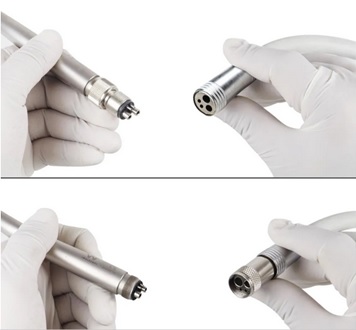
There’s no doubt that dental handpieces are essential tools in a dental practice. Technology has drastically improved over the years leading to the introduction of electric handpieces. These significantly improve dental procedures for promoting more precise preparations. Additionally, modern handpieces benefit patients and dentists for working noiselessly and without vibration. Below are some things to keep in mind before you buy dental handpieces.
Table of Contents
Head size
The diameter and height of the handpiece head matter. A handpiece with a small head allows greater visibility and ease of access. This comes in handy when handling dental procedures in the posterior area. However, a small head comes at a price of reduced torque to increase tooth preparation time. Larger head size for a handpiece gives it a large turbine impeller to increase inertial mass. This augments power output leading to less preparation time.
Noise level
Many people fear a visit to the dentist because of the dental drill. Introduction of audioanalgesia promoted patient comfort while undergoing various procedures. However, your patients will appreciate a handpiece with low noise. Compressed air rotates turbines in air-driven handpieces to generate considerable noise. The type of handpiece base connection affects the level of noise generated during a procedure.
Consider a device with low noise when buying A dental handpiece online. A device with the lowest decibel level minimizes patients’ fear and anxiety during procedures. Additionally, low noise pieces protect and preserve the clinician’s sense of hearing. An air turbine handpiece produces about 70 to 80 decibels of noise while that of their electric counterparts is about 55 to 60 decibels.
You may love to watch – UEFA EURO 2020: Germany vs Hungary Full Match Highlights
Speed and torque
Handpieces have varying speeds and torque. Air-driven pieces can reach speeds greater than 300,000 rpm easily while offering excellent torque. This is the ideal power you need consistently to maintain speed while cutting teeth and various dental materials.
Torque from an air turbine is compromised when working with dense materials like gold and zirconia slowing the handpiece. Electric handpieces have a speed of about 200,000 rpm. These maintain consistent power and torque regardless of the material you’re cutting through. Torque from a handpiece affects treatment time and comfort for the dentist and patient.
Weight
Another consideration when selecting a dental handpieces is weight. The weight of the tubing, motor, or coupling determines balance in the hand. This significantly affects use while handling various procedures. The weight of a handpiece determines ancestress injuries in the nerves and muscles with the forearms and hands more vulnerable.
The rule of thumb is to invest in a handpiece that you can handle appropriately. What works for you might not work for another person. Handpieces with slow speed can weigh double the weight of high-speed devices. Modern handpieces today have significantly reduced weight to allow working at a slow speed effortlessly.
Bearing
The type of bearing in the handpiece turbine is very important. Ceramic bearings have more resistance to wear and tear compared to stainless steel bearings. A handpiece with a damaged or worn bearing makes chatter and doesn’t cut concentrically. This makes the procedure very uncomfortable for patients and the dentist.
To reduce bur chatter encourages a definite cutting device to allow routine production of more precise margins effortlessly and much faster. Additionally, bur contacts the tooth for a short period producing less heat leading to enhanced bur lifespan and less sensitivity. This allows tooth preparation with precise margins and smoother walls without stress to the patient and dentist in less time.
Compatibility
Before purchasing a handpiece, you have to confirm whether it is compatible with the hose or coupling system in place. A device with quick disconnects saves time by allowing efficient replacements for patients. And, it promotes chair time more efficiently. You have to ensure that the handpiece you’re buying has compatible features with tools in place.
Maintenance
The rule of thumb is to buy a handpiece with a warranty. This hedges the device from mishaps and unexpected events that might happen. So, check the duration of the warranty before making a purchase. A warranty for handpieces usually lasts for a year but check for companies offering a longer warranty. Don’t forget to check the product fine print to understand what the warranty covers.
Ergonomics
Finally, it is very important to understand how the handpiece will feel in your hand. Maintaining a decent grip is very helpful for efficient use during various procedures. The ideal grip is smooth enough for optimal cleaning. Besides, the ideal handpiece should be compatible with the gloves you use. The nature of the grip significantly affects performance.
Conclusion
A successful dental practice needs to have all the necessary equipment in place. Handpieces are very useful gadgets that make performing various dental processes possible. So, due diligence is very important when looking to buy a handpiece. Buying online is a great thing to do right now but you have to ensure that the device has low noise, comes with a long warranty period, and offers a great grip.